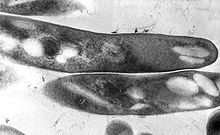User:Alexro25/Intracellular parasite
Article Draft
[edit]Lead
[edit]Intracellular parasites are organisms that make use of a host's cells for growth and replication. They are capable of penetrating host cells in an attempt to make use of their machinery. As parasites, they provide no benefits to the host and may be harmful in the process of cell takeover. To do so, these organisms must be small and generally consist of protozoans, bacteria, fungi, and viruses. These parasites also have specificity for the cell type they are able to invade.
The two main groupings of intracellular parasites consist of facultative and obligate organisms. This directly factors into the life cycle and hosts that are particular to each species. Their life cycle is further divided amongst the aspects of invading cells, as well as if and how they can survive in the absence of a host. As parasites, many species are known to cause a wide variety infections that may bring upon negative ramifications to the host. The study of their epidemiology is vital to understanding the distribution patterns and determinants of each organism.
Article body
[edit]Types of parasites
[edit]There are two main types of intracellular parasites: Facultative and Obligate.
Facultative
[edit]
Facultative intracellular parasites are capable of living and reproducing either inside or outside of host cells. These organisms use a variety of mechanisms to exist in extracellular conditions and evade host responses. However, their capabilities within a cell are more extensively studied and understood. Although these parasites are labeled 'facultative', the intracellular phase is of key importance to their life cycle.[1]
Obligate
[edit]Obligate intracellular parasites cannot reproduce outside their host cell, meaning that the parasite's reproduction is entirely reliant on intracellular resources. Many of these types of cells require specialized host types, and invasion of host cells occurs in different ways.
Cell Invasion
[edit]Various strategies are used by intracellular parasites in the process of entering a host cell. This can be separated into four phases: entry, survival/growth, replication, and exit. Each parasitic species makes use of their own mechanisms to complete this process and further infect other cells.
Prior to entry, the organisms must first locate and travel to the specific cell types they are targeting. As not all parasitic species have means to physically move themselves through the host, some can only do so through natural migration. The entry phase is defined by the various techniques they acquire to make it past the cell's defensive structures, such as the cell wall. Some of these strategies make use of the host cell's own structures to enter, while others have their own mechanisms that are not dependent on the host cell.[2]
Once within the host cell, the parasite must migrate to certain parts within the cell that allow them to grow and replicate. There are many aspects the organism must mediate, including obtaining nutrients, avoiding host defences, and limiting growth to the size of the cell. It is also very important for the parasite to not kill the cell it is inhabiting, as this would also remove a source of nutrients and growth, further destroying the parasite as well. With all of these factors mediated by the parasite, replication becomes a possibility.[3]
Following replication, the parasite must exit the cell in a similar fashion to how they entered. This can also be done by altering the intracellular conditions within the host cell to initiate exocytosis or active transport out.
Epidemiology
[edit]Some of the most common intracellular parasites around the world include individuals from the genera Toxoplasma, Plasmodium, Trypanosoma, Leishmania, as well as from phylum Microsporidia. Respectively, these organisms cause toxoplasmosis, malaria, Chagas disease, leishmaniasis and microsporidiosis in human hosts. Although each use various mechanisms to infiltrate the cells and have specificity for different areas of the body, all of the resulting illnesses cause millions of deaths to affected populations. [4] Developing an understanding of the distribution of each parasite worldwide, as well as the determinants of their respective illnesses, is the first presentative step.
References
[edit]- ^ Silva, Manuel T.; Pestana, Nazaré T.S. (March 2013). "The in vivo extracellular life of facultative intracellular bacterial parasites: role in pathogenesis". Immunobiology. 218 (3): 325–337.
- ^ Hammond, Datus M. (1971). Ecology and physiology of parasites. Toronto: University of Toronto Press. pp. 3–20.
- ^ Leiriāo, Patricia; Rodrigues, Cristina D.; Albuquerque, Sónia S.; Mota, Maria M (2004). "Survival of protozoan intracellular parasites in host cells". EMBO reports. 5 (12): 1142–1147.
- ^ Horta, Maria Fatima; Andrade, Luciana Oliveira; Martins-Duarte, Erica Santos; Castro-Gomes, Thiago (2020). "Cell invasion by intracellular parasites - the many roads to infection". The Company of Biologists. 133 (4).
